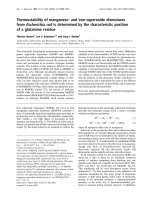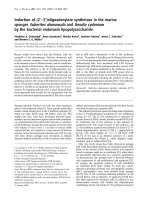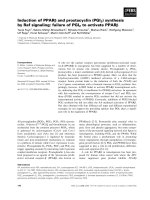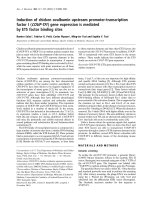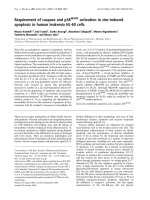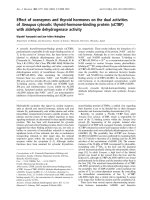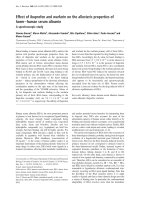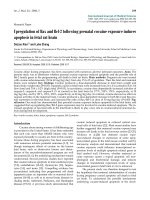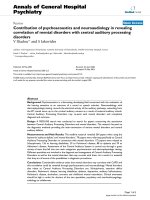Báo cáo y học: "Induction of p38- and gC1qR-dependent IL-8 expression in pulmonary fibroblasts by soluble hepatitis C core protein" pptx
Bạn đang xem bản rút gọn của tài liệu. Xem và tải ngay bản đầy đủ của tài liệu tại đây (797.73 KB, 11 trang )
BioMed Central
Page 1 of 11
(page number not for citation purposes)
Respiratory Research
Open Access
Research
Induction of p38- and gC1qR-dependent IL-8 expression in
pulmonary fibroblasts by soluble hepatitis C core protein
Jonathan P Moorman*
1,2
, S Matthew Fitzgerald
1
, Deborah C Prayther
1
,
Steven A Lee
1
, David S Chi
1
and Guha Krishnaswamy
1,2
Address:
1
Department of Internal Medicine, James H. Quillen College of Medicine, East Tennessee State University, Johnson City, TN, USA and
2
Medical Service, James H. Quillen VAMC, Johnson City, TN, USA
Email: Jonathan P Moorman* - ; S Matthew Fitzgerald - ;
Deborah C Prayther - ; Steven A Lee - ; David S Chi - ;
Guha Krishnaswamy -
* Corresponding author
Abstract
Background: Recent studies suggest that HCV infection is associated with progressive declines in
pulmonary function in patients with underlying pulmonary diseases such as asthma and chronic
obstructive pulmonary disease. Few molecular studies have addressed the inflammatory aspects of
HCV-associated pulmonary disease. Because IL-8 plays a fundamental role in reactive airway
diseases, we examined IL-8 signaling in normal human lung fibroblasts (NHLF) in response to the
HCV nucleocapsid core protein, a viral antigen shown to modulate intracellular signaling pathways
involved in cell proliferation, apoptosis and inflammation.
Methods: NHLF were treated with HCV core protein and assayed for IL-8 expression,
phosphorylation of the p38 MAPK pathway, and for the effect of p38 inhibition.
Results: Our studies demonstrate that soluble HCV core protein induces significant increases in
both IL-8 mRNA and protein expression in a dose- and time-dependent manner. Treatment with
HCV core led to phosphorylation of p38 MAPK, and expression of IL-8 was dependent upon p38
activation. Using TNFα as a co-stimulant, we observed additive increases in IL-8 expression. HCV
core-mediated expression of IL-8 was inhibited by blocking gC1qR, a known receptor for soluble
HCV core linked to MAPK signaling.
Conclusion: These studies suggest that HCV core protein can lead to enhanced p38- and gC1qR-
dependent IL-8 expression. Such a pro-inflammatory role may contribute to the progressive
deterioration in pulmonary function recently recognized in individuals chronically infected with
HCV.
Background
Hepatitis C virus (HCV), an RNA virus of the Flavivirus
family, is the most common blood-borne infection in the
United States [1,2]. A striking feature of HCV disease is the
high rate of progression to chronicity, with over 80% of
acutely infected individuals developing chronic inflam-
mation [3]. This inflammation has been associated with
liver failure, hepatocellular carcinoma and autoimmune
Published: 15 September 2005
Respiratory Research 2005, 6:105 doi:10.1186/1465-9921-6-105
Received: 08 April 2005
Accepted: 15 September 2005
This article is available from: />© 2005 Moorman et al; licensee BioMed Central Ltd.
This is an Open Access article distributed under the terms of the Creative Commons Attribution License ( />),
which permits unrestricted use, distribution, and reproduction in any medium, provided the original work is properly cited.
Respiratory Research 2005, 6:105 />Page 2 of 11
(page number not for citation purposes)
dysfunction [1]. Treatment for HCV is toxic and of limited
efficacy, and the majority of infected individuals do not
receive the antiviral therapies available.
Recently, HCV infection has been repeatedly linked to
progressive declines in pulmonary function in patients
with underlying lung diseases such as asthma and chronic
obstructive pulmonary disease (COPD) [4,5]. In patients
who already had a diagnosis of COPD, chronic HCV infec-
tion led to a more rapid decline in forced expiratory vol-
ume (FEV1) and diffusing capacity for carbon monoxide
(DLCO), findings that were abrogated in those treated
with interferon [4]. In a recent 6-year prospective trial,
asthmatic patients with chronic HCV who did not
respond to interferon had greater impaired reversibility to
bronchodilators when compared to either HCV-negative
controls or to HCV-positive individuals who responded to
interferon. [5] Some data suggests that HCV infection may
alter acetylcholine-mediated airway tone [5]. Other
smaller studies also suggest a role for HCV infection in
various pulmonary diseases, including idiopathic pulmo-
nary fibrosis [6,7].
While the pathogenesis of the progressive liver disease
that occurs with HCV infection involves fibrosis of hepatic
tissue in the setting of chronic inflammation, there are few
data available that address the inflammatory aspects of
HCV infection that lead to declines in lung function. Stud-
ies in chronically infected individuals have however dem-
onstrated increased levels of both serum and intrahepatic
cytokines, in particular interleukin-8 (IL-8), a chemokine
well-known to mediate inflammatory pulmonary proc-
esses [8,9]. IL-8 is involved in host inflammatory
responses and is synthesized by many different cell types,
including fibroblasts and epithelial cells. Expression of IL-
8 may inhibit the antiviral activity of interferon γ (IFN) [9]
and correlates with the degree of hepatic fibrosis and por-
tal inflammation during HCV infection [10,11]. While IL-
8 plays a significant role in pulmonary pathology in gen-
eral [12], its role in pulmonary disease specifically associ-
ated with HCV has not been addressed.
IL-8 signaling is characterized by the integration of at least
three different signaling pathways that coordinate induc-
tion of mRNA synthesis or that suppress mRNA degrada-
tion [13]. Current models suggest that maximal IL-8 can
be generated upon de-repression of the gene promoter,
activation of NFκB and JNK pathways, and stabilization of
the resulting mRNA by p38 MAPK signaling. ERK signal-
ing also contributes to IL-8 induction, although it does
not appear to be a potent inducer. TNFα likely activates all
of these pathways and has served as a model for robust IL-
8 signaling.
Interestingly, we and other investigators have found that
the nucleocapsid core protein of HCV may modulate
immune signaling pathways, including those mediated by
receptors such as gC1qR, TNFR1, and Fas [14-16]. This
protein has been found in serum in naked form [17], and
soluble core protein can bind and signal extracellularly via
the complement receptor, gC1q, on lymphocytes [15].
HCV core appears to be the most potent signal inducer of
the IL-8 promoter in hepatocytes transfected with viral
protein-reporter expression vectors [18].
We would like to better understand the mechanisms by
which chronic HCV infection leads to a more progressive
pulmonary decline in individuals with chronic lung dis-
ease. Because HCV core antigen can modulate immune
signaling pathways that affect IL-8 transcription, we exam-
ined the role of soluble HCV core protein in IL-8 signaling
in pulmonary fibroblasts. We document an HCV core-
induced increase in IL-8 mRNA and protein expression in
fibroblasts that is both dose- and time-dependent. We
demonstrate that this increase is associated with activa-
tion of p38 MAPK that this activation is necessary. We
show that co-signaling with TNFα and HCV core leads to
augmentation of IL-8 gene and protein expression.
Finally, we document that HCV core-mediated IL-8 up-
regulation can be inhibited using antibodies that block
gC1qR, a known receptor for soluble HCV core antigen.
Materials and methods
Tissue Culture
Normal human lung fibroblasts (NHLF) (Clonetics-Bio-
Whittaker, Walkersville, MD) were grown in fibroblast
basal medium (Clonetics-BioWhittaker, Walkersville,
MD) at 5% CO
2
at 37°C. Media was supplemented with
2% fetal bovine serum, human fibroblast growth factor-B
(1.0 µg/mL), insulin (5 mg/mL), gentamicin and ampho-
tericin B. NHLF were cultured in 12 well culture plates at
a cell concentration of 5 × 10
4
cells per well and incubated
overnight. β-galactosidase-HCV core antigen (1–191)
fusion proteins (core) or β-galactosidase control proteins
(β-gal) (endotoxin-negative; Virogen, Watertown, MA)
were added at the indicated concentrations based on pre-
vious studies of soluble core antigen [15,19] and incu-
bated for 24 hours. Time course experiments were done in
the same manner for 12, 24, and 48 hours. Tumor necro-
sis factor α (TNFα) was added at 1 U/mL with and without
HCV core antigen and incubated for 24 hours. Inhibition
of p38 MAPK studies were done using the specific inhibi-
tor, SB203580 (Calbiochem, San Diego, CA) as described
[20]. NHLF were pretreated with SB203580 (10 µM) for
two hours prior to addition of HCV core antigen or con-
trol proteins. Murine gC1qR-specific antibodies (Chemi-
con, Temicula, CA) were used at two different
concentrations as described.
Respiratory Research 2005, 6:105 />Page 3 of 11
(page number not for citation purposes)
Enzyme Linked Immunosorbent Assay (ELISA)
Enzyme linked immunosorbent assay (ELISA) was used to
detect IL-8 levels in cell-free supernatants as previously
described using commercially available kits (R&D Sys-
tems, Minneapolis, MN) [20]. Values were extrapolated or
interpolated from a standard curve. Results were analyzed
on an ELISA plate reader (Dynatech MR 5000 with sup-
porting software).
IL-8 Gene Expression by RT-PCR
Gene expression for IL-8 was assessed using RT-PCR as
previously described [21]. RNA was extracted by a RNAzol
technique from cultured cells. Briefly, total cellular RNA
was extracted from cultured cells (1 × 10
6
cells) by the
addition of 1.1 mL of RNAzol B (Tel-Test, Inc., Friends-
wood, Texas). The suspension was shaken for 1 minute
and centrifuged at 12,000 × g for 15 minutes at 4°C. The
aqueous phase was washed twice with 0.8 ml phe-
nol:chloroform (1:1, v/v), and once with 0.8 mL of chlo-
roform. Each time, the suspension was centrifuged at
12,000 × g for 15 minutes at 4°C. An equal volume of iso-
propanol was added to the aqueous phase, and the prep-
aration refrigerated at -20°C overnight. After
centrifugation at 12,000 × g for 30 minutes at 4°C, the
RNA pellet was washed with 75% ethanol. The RNA pellet
was air dried and suspended in 20 µl of DEPC-treated
water. RNA was quantitated by optical density readings at
260 nm, and the integrity of the 28S and 18S RNA bands
determined by electrophoresis in ethidium bromide-
stained agarose gels. First strand cDNA was synthesized in
the presence of murine leukemia virus reverse tran-
scriptase (2.5 U/µL), 1 mM each of the nucleotides dATP,
dCTP, dGTP and dTTP; RNase inhibitor (1 U/µL), 10×
PCR buffer (500 mM KCl, 100 mm Tris-HCl, pH 8.3), and
MgCl
2
(5 mM), using oligo(dT)
16
(2.5 mM) as a primer.
The preparation was incubated at 42°C for 20 minutes in
a DNA thermocycler (Perkin-Elmer Corp., Norwalk, CT)
for reverse transcription. PCR amplification was done on
aliquots of the cDNA in the presence of MgCl
2
(1.8 mM),
dNTPs (0.2 mM), and AmpliTaq polymerase (1 U/50 µL),
and paired cytokine-specific primers (0.2 nM of each
primer) to a total volume of 50 µl. Paired primers for the
housekeeping gene hypoxanthine phosphoribosyltrans-
ferase (HPRT) were employed as a control for gene expres-
sion. PCR consisted of 1 cycle of 95°C for 2 min, 45 cycles
of 95°C for 45 sec, 60°C for 45 sec, and 72°C for 1 min
30 sec, and lastly, 1 cycle of 72°C for 10 min. Fourteen
microliters of the amplified products were subjected to
electrophoresis on a 2% agarose gel stained with ethidium
bromide. IL-8 gene products were confirmed by fragment
size.
Immunofluorescent Staining
NHLF were cultured on sterile coverslips overnight and
subsequently treated with β-gal or core (1 µg/ml) for 30
minutes to three hours. Cells were fixed by immersion in
ice-cold methenol:acetone (1:1) for ten minutes at 20°C.
Coverslips were air-dried and cells blocked with 1% nor-
mal donkey serum (Jackson Laboratories, West Grove,
PA) in PBS for thirty minutes. A primary polyclonal rabbit
antibody to phosphorylated p38 (Cell Signaling Tech,
Beverly, MA) was diluted 1:200 in 1% normal donkey
serum/PBS and incubated with cells for 1.5 hr at room
temperature. Cells were washed three times using PBS
with Tween-20 at five minute intervals. A secondary don-
key-anti-rabbit antibody conjugated to Cy
tm
3 (Jackson
Laboratories, West Grove, PA) was applied at 1:200 and
incubated for 45 minutes in the dark. Three washes with
PBST were performed at five minute intervals and cover-
slips were mounted to slides and viewed using an Olym-
pus BX41 fluorescent microscope at 570 nm.
Statistical Analysis
All experiments were done in triplicate. All values are
given as the mean ± standard deviation (SD). Statistical
analysis was done using the Students t-test and Statistica
version 5 computer software (StatSoft, Inc Tulsa, OK). A p-
value of < 0.05 was considered significant.
Results
HCV core protein induces IL-8 protein and gene expression
Recent studies have demonstrated that the core protein of
HCV can signal extracellularly and that naked core protein
is present in the serum of infected individuals [17]. To
examine the role of soluble core protein in cytokine sign-
aling in fibroblasts, we employed normal human lung
fibroblasts (NHLF), which have been used as a model for
cytokine expression. β-galactosidase-HCV core (1–191)
fusion proteins or control β-galactosidase (β-gal) proteins
were added to NHLF cultures at doses ranging from 1–3
µg/ml and incubated for 24 hours. These commercially
available fusion proteins were confirmed to be endotoxin-
negative and have been extensively used in studies explor-
ing the role of HCV core in immune modulation
[15,22,23]. Culture supernatants were used in an IL-8
ELISA assay (figure 1A) and cells were analyzed for IL-8
mRNA expression at 24 hours using RT-PCR, with HPRT
as a control for RNA loading (figure 1B). Cells exposed to
HCV core protein demonstrated significant up-regulation
of both IL-8 protein and mRNA expression that was not
seen in either mock- or β-gal-treated control cells as meas-
ured by ELISA. No concentration of β-gal control proteins
up to 3 µg/ml elicited any IL-8 gene expression or protein
production. In addition, there was no increase in expres-
sion of other cytokines, including IL-6, MCP-1, TNFα, and
IL-1β, when assayed by ELISA (data not shown).
To analyze the kinetics of IL-8 induction, IL-8 protein
expression was determined at multiple time points fol-
lowing treatment of fibroblasts with HCV core protein
Respiratory Research 2005, 6:105 />Page 4 of 11
(page number not for citation purposes)
(figure 2). Cells treated with HCV core continued to
exhibit increasing levels of IL-8 production over 48 hours
that were significantly and consistently elevated above
mock- or β-gal-treated controls. These data suggested that
HCV core significantly induced IL-8 up-regulation leading
to enhanced protein expression in a dose- and time-
dependent manner.
Increased IL-8 up-regulation upon co-treatment with HCV
core protein and TNF
α
Intrahepatic levels of TNFα and IL-8 have been shown to
be elevated in individuals with chronic hepatitis C infec-
tion [11]. Several investigators have suggested that HCV
core protein might modulate or perhaps mimic TNFR1
signaling [24,25] and core protein has been shown to
bind the cytoplasmic domain of TNFR1 [16]. Since TNFα
is a strong inducer of IL-8 signaling, we wanted to deter-
mine how HCV core stimulus interacts with concomitant
TNFα signaling. To accomplish this, IL-8 protein and
mRNA expression were assayed in NHLF cells co-cultured
with HCV core protein and TNFα (figure 3).
In these experiments, individual TNFα treatment and
HCV core treatments, as expected, led to significant
increases in IL-8 induction as measured by both protein
(figure 3A) and gene expression (figure 3B). In cells co-
treated with both TNFα and HCV core protein, however,
there was an additive increase in IL-8 induction beyond
what would be expected if core was mimicking TNFα and
signaling only through TNFR1. The addition of antibody
to TNFα to cells treated with core protein did not inhibit
core-mediated IL-8 expression (data not shown).
HCV core-mediated IL-8 secretion is dependent upon p38
phosphorylation
IL-8 signaling is a complex set of events that involves acti-
vation of several MAPK members, including most notably
NFκB but also variably ERK and JNK. Efficient IL-8 signal-
ing appears to require activation by transcription factors,
such as NFκB, as well as stabilization of the resulting
mRNA by p38 signaling. Because our data demonstrated a
significant induction of IL-8 gene expression and protein
production upon HCV core treatment, we wanted to
determine if elements of these signaling pathways were
being activated.
p38 plays a key role in effective IL-8 responses. [13] To
examine the role of p38 signaling in HCV core-mediated
responses, NHLF cells were either mock-treated or treated
with β-gal or HCV core and incubated for two hours. Cells
were harvested, lysed, and analyzed by immunoblotting
using antibodies specific for both the native and the phos-
phorylated forms of p38 (figure 4A). These experiments
demonstrated phosphorylation of p38 upon treatment
with HCV core protein.
Dose-dependent increase in IL-8 expression by HCV core proteinFigure 1
Dose-dependent increase in IL-8 expression by HCV core
protein. A, NHLF were subjected to mock treatment or
treatment with β-galactosidase or (β-gal) or β-galactosidase-
HCV core protein (Core) at the indicated concentrations,
incubated for 24 h, and supernatants assayed for IL-8 by
ELISA as described in Materials and Methods. Experiments
were done in triplicate. B, NHLF were subjected to mock
treatment or treatment with β-galactosidase (β-gal) or β-
galactosidase-HCV core protein (Core) at the indicated con-
centrations and incubated for 24 h. Lysates were harvested,
RNA isolated and reverse transcribed, and IL-8 detected
using IL-8 specific primers or HPRT as a control for RNA
loading as described in Materials and Methods.
A
B
Respiratory Research 2005, 6:105 />Page 5 of 11
(page number not for citation purposes)
To confirm these findings, NHLF cells were again mock-
treated or treated with β-gal or HCV core protein and incu-
bated for 30 minutes to three hours. Cells were fixed and
immunostained with antibody to phosphorylated forms
of p38 and visualized by fluorescent microscopy (figure
4B). We observed nuclear localization of phosphorylated
p38 consistent with activation upon treatment with core
at 30 minutes. A washout effect was noted, with dimin-
ished signaling within the nucleus evident by three hours.
Because HCV core was associated with both increased IL-
8 and p38 signaling, we assayed the ability of the p38
inhibitor SB203580 to inhibit overall IL-8 protein expres-
sion in these cells (figure 5). NHLF were mock-treated or
treated with β-gal or HCV core protein, with or without
the addition of SB203580, and incubated for 24 hours. IL-
8 protein expression was determined by ELISA. These
experiments demonstrated up-regulation of IL-8 protein
expression by HCV core that was completely inhibited by
the addition of SB203580, and suggested that p38 signal-
ing is necessary for optimal IL-8 expression induced by
HCV core protein.
HCV core-induced IL-8 expression is dependent upon
gC1qR
Recent investigations into HCV core protein have demon-
strated that soluble core interacts with the complement
receptor, gC1q and alters intracellular signals including
MAPK. Because soluble HCV core affected the p38 MAPK
signaling pathway, we wanted to assess whether this was
occurring via a gC1qR-dependent process in a manner
similar to experiments done in lymphocytes. Expression
of gC1qR on pulmonary fibroblasts was confirmed by
immunoblotting with antibody to gC1qR (figure 6A).
Notably, treatment with β-gal, HCV core protein, or TNFα
did not alter receptor expression level.
NHLF were subjected to treatment with β-gal, HCV core
protein, HCV core protein with anti-gC1qR antibody, or
HCV core protein with control isotypic antibody and IL-8
Time-dependent increase in IL-8 expression by HCV core proteinFigure 2
Time-dependent increase in IL-8 expression by HCV core protein. NHLF were mock-treated or treated with β-galactosidase
(β-gal) or β-galactosidase-HCV core protein (Core) at the indicated concentrations. Supernatants were collected at 12, 24, and
48 h and IL-8 expression assayed by ELISA as described in Materials and Methods. All assays were done in triplicate.
Respiratory Research 2005, 6:105 />Page 6 of 11
(page number not for citation purposes)
Additive increase in TNFα-induced IL-8 expression by HCV core proteinFigure 3
Additive increase in TNFα-induced IL-8 expression by HCV core protein. A, NHLF were subjected to mock treatment or
treatment with β-galactosidase (β-gal), β-galactosidase-HCV core protein (Core), TNFα, or Core and TNFα at the indicated
concentrations and incubated for 24 h. Supernatants were assayed for IL-8 by ELISA as described in Materials and Methods.
Experiments were done in triplicate. B, NHLF were treated to the above conditions and incubated for 24 h. Lysates were har-
vested, RNA isolated and reverse transcribed, and IL-8 detected using IL-8 specific primers or HPRT as a control for RNA
loading as described in Materials and Methods.
A
B
Respiratory Research 2005, 6:105 />Page 7 of 11
(page number not for citation purposes)
Phosphorylation of p38 in response to HCV core proteinFigure 4
Phosphorylation of p38 in response to HCV core protein. A, Western blot analysis of human fibroblasts. NHLF were subjected
to mock treatment (lane 1) or treatment with β-galactosidase (1 µg/ml) (lane 2) or β-galactosidase-HCV core protein (1 µg/ml)
(lane 3) and incubated for 2 hours. Whole cell lysates of NHLF were subjected to SDS-PAGE and immunoblotted with antibod-
ies specific for either p38 or phosphorylated p38 (p38-p) as indicated. B, Immunofluorescent staining of NHLF (40×). NHLF
cultured on coverslips were subjected to mock treatment or treatment with β-galactosidase (β-gal) or β-galactosidase-HCV
core protein (Core) at the indicated concentrations and incubated for 30 min or 3 hr as indicated. Cells were fixed with meth-
anol:acetone (1:1) prior to immunofluorescent staining using an antibody to phosphorylated 38 and a secondary Cy
tm
3-conju-
gated antibody. Cells were viewed and photographed using an Olympus BX41 microscope at 570 nm.
A
B
p38-p
p38
12
3
Mock
30 min
β-gal (1 µg/mL)
30 min
Core (1 µg/mL)
30 min
Core (1 µg/mL)
3hr
Respiratory Research 2005, 6:105 />Page 8 of 11
(page number not for citation purposes)
expression was assayed by ELISA (figure 6B). As in our
previous experiments, HCV core induced IL-8 expression,
and this was not affected by addition of murine IgG anti-
body. Induction of IL-8 was, however, partially blocked
by antibody to gC1qR at two different doses. These data
suggest that IL-8 expression induced by HCV core protein
is at least partially dependent upon signaling via gC1qR.
Discussion
The association of HCV infection with declines in pulmo-
nary function has only recently been recognized in clinical
studies. Our study represents a first attempt to examine
the pathogenesis of this process. In this study, we demon-
strate that the core nucleocapsid protein of hepatitis C
virus induces the up-regulation of a key inflammatory
cytokine, IL-8, in pulmonary fibroblasts. Treatment with
soluble HCV core antigen led to increases in both IL-8
message and protein that augmented TNFα-induced IL-8
expression. This core-induced up-regulation was
associated with p38 activation, which was required for
core-induced signaling. IL-8 up-regulation was also
dependent upon gC1qR, a known receptor for soluble
HCV core.
It is important to note that our studies involved direct
extracellular delivery of HCV core protein. The vast major-
ity of studies involving HCV core have employed transfec-
tion techniques to deliver HCV proteins intracellularly,
with the assumption that this would mimic viral infection
of the given cell being studied. Using these techniques, we
and other investigators have noted intracellular interac-
tions with various immunomodulatory receptors, includ-
ing Fas[14], TNFR [16], and LTβR[26], mediated in
Inhibition of HCV-core induced IL-8 expression by SB203580Figure 5
Inhibition of HCV-core induced IL-8 expression by
SB203580. NHLF were either mock-treated or treated with
DMSO vehicle, SB203580, β-galactosidase (β-gal), β-galactos-
idase-HCV core protein (Core), or Core and SB203580 at
the indicated concentrations and incubated for 24 hr. IL-8
protein expression was assayed by ELISA as described above.
Inhibition of HCV-core induced IL-8 expression by antibody to gC1qRFigure 6
Inhibition of HCV-core induced IL-8 expression by antibody
to gC1qR. A. gC1qR expression in NHLF. NHLF were mock-
treated (1) or treated with β-galactosidase (2), β-galactosi-
dase-HCV core protein (3), or β-galactosidase-HCV core
protein and TNFα (4) and incubated for 24 h. Whole cell
lysates of NHLF were subjected to SDS-PAGE, immunoblot-
ted with antibodies specific for gC1qR, and visualized using
ECL. A 33 kD protein was identified. B. Inhibition of HCV
core-induced IL-8 expression by gC1qR. NHLF were mock-
treated (Mock) or treated with β-galactosidase (β-gal), β-
galactosidase-HCV core protein (Core), or β-galactosidase-
HCV core protein with either antibody to gC1qR at the indi-
cated concentrations or mouse IgG at 1 µg/ml. Supernatants
were collected at 24 h and IL-8 expression assayed by ELISA
as described in Materials and Methods. All assays were done
in triplicate.
A
1234
B
Respiratory Research 2005, 6:105 />Page 9 of 11
(page number not for citation purposes)
general through the cytoplasmic domains of those
receptors.
Several studies however have now reported that nanomo-
lar amounts of core protein are detected in the circulating
blood of HCV-infected patients [17,27,28], and that core
protein is secreted from transfected cell lines [29]. This has
raised the possibility that HCV core can function extracel-
lularly as a signaling antigen as a means of modulating
immune responses. Recent studies focusing on the inter-
action of soluble core antigen with gC1qR have provided
exciting and novel mechanisms by which HCV core might
be exerting its immunomodulatory effects [30]. As noted
by other investigators, the amounts secreted from trans-
fected cell lines are similar to those employed in our and
other investigators' studies of soluble core protein
[15,19].
Our findings that HCV core antigen activates MAPK path-
ways involved in cytokine signaling is supported by mul-
tiple previous investigations. In a tetracycline-regulated
system used to express HCV core in HepG2 cells, core
expression led to activation of ERK, JNK, and p38 path-
ways and to an increase in cellular proliferation [31]. Sim-
ilarly, studies have shown that stable transfection of HCV
core results in activation of JNK and AP-1 [32]. Upon co-
tranfection of HCV proteins and an IL-8 reporter plasmid
into mammalian cells, HCV core exhibited the strongest
effect on intracellular signaling pathways and activated
the IL-8 promoter via NFκB and AP-1 [18]. These studies,
however, focused primarily on signaling pathways and
promoter activity rather than gene expression per se. Our
data demonstrate that activation of at least some of these
pathways does ultimately result in detectable gene and
protein expression in pulmonary fibroblasts.
It is notable that multiple other HCV gene products have
been associated with IL-8 upregulation, including HCV E2
[33], NS4A and 4B [34], and NS5A [9,35]. These studies
were performed primarily in hepatocytyes or HeLa cells,
but the effect of these gene products on pulmonary
fibroblast signaling is yet to be examined. It is certainly
feasible that multiple HCV proteins contribute to
chemokine upregulation and inflammation in pulmonary
fibroblasts, and this possibility should be the focus of
future studies.
Our experiments suggest that the ability of HCV core to
up-regulate IL-8 expression may be dependent upon p38
phosphorylation. This is perhaps not surprising given the
putative role for p38 in stabilizing mRNA following acti-
vation of IL-8 at the transcriptional level. In current
models of IL-8 signaling, p38 activation is necessary for
maximal IL-8 production following stimulation [13]. Our
studies would suggest that HCV core provides activation
of p38 signaling, which is associated with robust IL-8 up-
regulation in multiple cell types [12,36]. We cannot at this
point rule out that other MAPKs, such as JNK and perhaps
ERK, are not also involved in the HCV core-mediated up-
regulation of IL-8. These studies are ongoing in our
laboratory.
Soluble core antigen has been shown to inhibit human T
cell responses via the complement receptor, gC1qR, which
interestingly involved an inhibition of the ERK/MEK
MAPK signaling pathway in these T cells [15,19,22]. HCV
core can directly and extracellularly bind gC1qR, a phe-
nomenon which is saturable at core concentrations of 3
µg/ml [19]. gC1qR is expressed on pulmonary fibroblasts,
and our data suggest that IL-8 up-regulation by soluble
HCV core in NHLF is at least partially dependent upon
this receptor. It is notable that a similar induction of IL-8
expression via gC1qR was observed in HUVEC endothe-
lial cells and was also mediated through MAPK-depend-
ent processes [37]. Ongoing studies are examining the
effect of blocking gC1qR on NFκB signaling and on MAPK
signals such as p38, JNK, and ERK.
Notably, IL-8 has been found to be a key mediator of pul-
monary inflammation and reactive airway disease [12].
Patients with persistent asthma have an influx of neu-
trophils and increased local pulmonary IL-8 levels [38].
Because IL-8 has been shown to directly provoke bron-
choconstriction [39], it presumably contributes to the
establishment of chronic reactive airway disease directly
and indirectly by stimulating neutrophil recruitment and
activation. Activation of transcription factors or kinase
pathways leading to up-regulation of IL-8 expression has
been implicated in the pathogenesis of multiple other
viral infections, including adenovirus (ERK), CMV
(NFκB), and KSHV (p38, JNK) [12].
The pro-inflammatory characteristics of HCV core protein
described in our studies may be of key importance to clin-
ical infection. Individuals with chronic HCV infection
have evidence of upregulated IL-8 responses, including
increased levels of IL-8 mRNA in liver biopsies from
infected patients [8,10,11] and increased IL-8 protein
detectable in serum compared to controls [8,9](unpub-
lished observations, JPM.) Notably, intrahepatic IL-8
mRNA levels have correlated with both hepatic fibrosis
and inflammatory indices and were associated with resist-
ance to interferon therapy [9,11].
It is possible that a similar phenomenon is occurring in
pulmonary tissue in response to HCV core and
contributes to the declines in pulmonary function
associated with active HCV infection [4,5]. In such a
model, circulating core antigen would bind to gC1qR dis-
played on the surface of pulmonary fibroblasts and trigger
Respiratory Research 2005, 6:105 />Page 10 of 11
(page number not for citation purposes)
the phosphorylation/activation of p38, NFκB, and possi-
bly other MAPK mediators. This would lead to enhanced
IL-8 gene transcription and protein expression, increased
neutrophil recruitment at the local level, and ultimately
the deterioration in pulmonary function observed in
HCV-infected patients with lung disease [4,5,7]. It is note-
worthy that patients with HCV infection even in the
absence of pulmonary symptoms have been found to
have increased numbers of neutrophils in bronchoalveo-
lar fluid samples [7].
Conclusion
Our studies point to a role for HCV core protein in up-reg-
ulating IL-8 mRNA and protein expression in a p38- and
gC1qR-dependent manner and support much of the
growing body of literature that suggests that HCV core is
pro-inflammatory in specific cells. Further dissection of
the pathways involved in HCV core-mediated signaling
may provide a clearer understanding of the pathogenesis
of pulmonary and hepatic disease in HCV-infected indi-
viduals and provide targets for modulating its effects.
Abbreviations
HCV: hepatitis C virus
NHLF: normal human lung fibroblasts
IL-8: interleukin 8
MAPK: mitogen-activated protein kinase
BALF: Bronchoalveolar lavage fluid
EBV, Epstein-Barr virus
IFN, interferon
LPS, lipopolysaccharide
CMV: cytomegalovirus
KSHV: Kaposi's sarcoma-associated herpes virus
ELISA, enzyme-linked immunosorbent assay
DLCO: diffusing capacity for carbon monoxide
FEV1: forced expiratory volume at one second
COPD: chronic obstructive pulmonary disease
JNK: jun-kinase
NFκB: nuclear factor kappa B
TNFR: tumor necrosis factor receptor
HPRT: hypoxanthine phosphoribosyltransferase
PMSF: phenylmethylsulfonyl fluoride
PAGE: polyacrylamide gel electrophoresis
Competing interests
The author(s) declare that they have no competing
interests.
Authors' contributions
JPM conceived the study, participated in its design, coor-
dinated all experiments and drafted the manuscript. SMF
carried out the IL-8 immunoassays and RT-PCR reactions
and helped draft the manuscript. DCP completed all
immunofluorescence studies. SAL carried out experi-
ments involving TNFα including immunoassays. DSC
participated in study design and data interpretation and
provided critical manuscript review. GK participated in
the study design, coordinated experiments, and drafted
the manuscript in coordination with JPM. All authors read
and approved the final manuscript.
Acknowledgements
The authors would like to acknowledge Dr. Donald Hoover for his exper-
tise in fluorescent microscopy. This work was funded by NIH grantsR15 AI-
43310 andRO1 HL-63070 (to G.K.), the Chair of Excellence in Medicine
(State of Tennessee grant 20233), Cardiovascular Research Institute, and
the ResearchDevelopment Committee, East Tennessee State University.
References
1. Alter MJ, Margolis HS, Krawczynski K, Judson FN, Mares A, Alexan-
der WJ, Hu PY, Miller JK, Gerber MA, Sampliner RE, et al.: The nat-
ural history of community-acquired hepatitis C in the United
States. The Sentinel Counties Chronic non-A, non-B Hepati-
tis Study Team [see comments]. New England Journal of Medicine
1992, 327:1899-1905.
2. Moorman JP: Challenges in the HIV patient co-infected with
hepatitis C. Curr Hep Rep 2002, 1:9-15.
3. Moorman JP, Joo M, Hahn Y: Evasion of host immune surveil-
lance by hepatitis C virus: potential roles in viral persistence.
Arch Immunol Ther Exp (Warsz) 2001, 49:189-194.
4. Kanazawa H, Hirata K, Yoshikawa J: Accelerated decline of lung
function in COPD patients with chronic hepatitis C virus
infection: a preliminary study based on small numbers of
patients. Chest 2003, 123:596-599.
5. Kanazawa H, Yoshikawa J: Accelerated decline in lung function
and impaired reversibility with salbutamol in asthmatic
patients with chronic hepatitis C virus infection: a 6-year fol-
low-up study. Am J Med 2004, 116:749-752.
6. Manganelli P, Salaffi F, Pesci A: [Hepatitis C virus and pulmonary
fibrosis]. Recenti Prog Med 2002, 93:322-326.
7. Idilman R, Cetinkaya H, Savas I, Aslan N, Sak SD, Bastemir M, Sarioglu
M, Soykan I, Bozdayi M, Colantoni A, Aydintug O, Bahar K, Uzunali-
moglu O, Van Thiel DH, Numanoglu N, Dokmeci A: Bronchoalve-
olar lavage fluid analysis in individuals with chronic hepatitis
C. J Med Virol 2002, 66:34-39.
8. Kaplanski G, Farnarier C, Payan MJ, Bongrand P, Durand JM:
Increased levels of soluble adhesion molecules in the serum
of patients with hepatitis C. Correlation with cytokine con-
centrations and liver inflammation and fibrosis. Dig Dis Sci
1997, 42:2277-2284.
Publish with BioMed Central and every
scientist can read your work free of charge
"BioMed Central will be the most significant development for
disseminating the results of biomedical research in our lifetime."
Sir Paul Nurse, Cancer Research UK
Your research papers will be:
available free of charge to the entire biomedical community
peer reviewed and published immediately upon acceptance
cited in PubMed and archived on PubMed Central
yours — you keep the copyright
Submit your manuscript here:
/>BioMedcentral
Respiratory Research 2005, 6:105 />Page 11 of 11
(page number not for citation purposes)
9. Polyak SJ, Khabar KS, Rezeiq M, Gretch DR: Elevated levels of
interleukin-8 in serum are associated with hepatitis C virus
infection and resistance to interferon therapy. J Virol 2001,
75:6209-6211.
10. Shimoda K, Begum NA, Shibuta K, Mori M, Bonkovsky HL, Banner BF,
Barnard GF: Interleukin-8 and hIRH (SDF1-alpha/PBSF)
mRNA expression and histological activity index in patients
with chronic hepatitis C. Hepatology 1998, 28:108-115.
11. Mahmood S, Sho M, Yasuhara Y, Kawanaka M, Niiyama G, Togawa K,
Ito T, Takahashi N, Kinoshita M, Yamada G: Clinical significance of
intrahepatic interleukin-8 in chronic hepatitis C patients.
Hepatol Res 2002, 24:413-419.
12. Mukaida N: Pathophysiological roles of interleukin-8/CXCL8
in pulmonary diseases. Am J Physiol Lung Cell Mol Physiol 2003,
284:L566-77.
13. Hoffmann E, Dittrich-Breiholz O, Holtmann H, Kracht M: Multiple
control of interleukin-8 gene expression. J Leukoc Biol 2002,
72:847-855.
14. Moorman JP, Prayther D, McVay D, Hahn YS, Hahn CS: The C-ter-
minal region of hepatitis C core protein is required for Fas-
ligand independent apoptosis in Jurkat cells by facilitating
Fas oligomerization. Virology 2003, 312:320-329.
15. Kittlesen DJ, Chianese-Bullock KA, Yao ZQ, Braciale TJ, Hahn YS:
Interaction between complement receptor gC1qR and hep-
atitis C virus core protein inhibits T-lymphocyte
proliferation. J Clin Invest 2000, 106:1239-1249.
16. Zhu N, Khoshnan A, Schneider R, Matsumoto M, Dennert G, Ware
C, Lai MM: Hepatitis C virus core protein binds to the cyto-
plasmic domain of tumor necrosis factor (TNF) receptor 1
and enhances TNF-induced apoptosis. Journal of Virology 1998,
72:3691-3697.
17. Masalova OV, Atanadze SN, Samokhvalov EI, Petrakova NV, Kalinina
TI, Smirnov VD, Khudyakov YE, Fields HA, Kushch AA: Detection
of hepatitis C virus core protein circulating within different
virus particle populations. J Med Virol 1998, 55:1-6.
18. Kato N, Yoshida H, Kioko Ono-Nita S, Kato J, Goto T, Otsuka M, Lan
K, Matsushima K, Shiratori Y, Omata M: Activation of intracellular
signaling by hepatitis B and C viruses: C-viral core is the
most potent signal inducer. Hepatology 2000, 32:405-412.
19. Yao ZQ, Eisen-Vandervelde A, Waggoner SN, Cale EM, Hahn YS:
Direct binding of hepatitis C virus core to gC1qR on CD4+
and CD8+ T cells leads to impaired activation of Lck and Akt.
J Virol 2004, 78:6409-6419.
20. Fitzgerald SM, Lee SA, Hall HK, Chi DS, Krishnaswamy G: Human
lung fibroblasts express interleukin-6 in response to signaling
after mast cell contact. Am J Respir Cell Mol Biol 2004, 30:585-593.
21. Krishnaswamy G, Smith JK, Mukkamala R, Hall K, Joyner W, Yerra L,
Chi DS: Multifunctional cytokine expression by human coro-
nary endothelium and regulation by monokines and
glucocorticoids. Microvasc Res 1998, 55:189-200.
22. Yao ZQ, Eisen-Vandervelde A, Ray S, Hahn YS: HCV core/gC1qR
interaction arrests T cell cycle progression through stabiliza-
tion of the cell cycle inhibitor p27Kip1. Virology 2003,
314:271-282.
23. Yao ZQ, Nguyen DT, Hiotellis AI, Hahn YS: Hepatitis C virus core
protein inhibits human T lymphocyte responses by a com-
plement-dependent regulatory pathway. J Immunol 2001,
167:5264-5272.
24. You LR, Chen CM, Lee YH: Hepatitis C virus core protein
enhances NF-kappaB signal pathway triggering by lympho-
toxin-beta receptor ligand and tumor necrosis factor alpha.
J Virol 1999, 73:1672-1681.
25. Park KJ, Choi SH, Koh MS, Kim DJ, Yie SW, Lee SY, Hwang SB: Hep-
atitis C virus core protein potentiates c-Jun N-terminal
kinase activation through a signaling complex involving
TRADD and TRAF2. Virus Res 2001, 74:89-98.
26. Matsumoto M, Hsieh TY, Zhu N, VanArsdale T, Hwang SB, Jeng KS,
Gorbalenya AE, Lo SY, Ou JH, Ware CF, Lai MM: Hepatitis C virus
core protein interacts with the cytoplasmic tail of lympho-
toxin-beta receptor. Journal of Virology 1997, 71:1301-1309.
27. Maillard P, Krawczynski K, Nitkiewicz J, Bronnert C, Sidorkiewicz M,
Gounon P, Dubuisson J, Faure G, Crainic R, Budkowska A: Nonen-
veloped nucleocapsids of hepatitis C virus in the serum of
infected patients. J Virol 2001, 75:8240-8250.
28. Widell A, Molnegren V, Pieksma F, Calmann M, Peterson J, Lee SR:
Detection of hepatitis C core antigen in serum or plasma as
a marker of hepatitis C viraemia in the serological window-
phase. Transfus Med 2002, 12:107-113.
29. Sabile A, Perlemuter G, Bono F, Kohara K, Demaugre F, Kohara M,
Matsuura Y, Miyamura T, Brechot C, Barba G: Hepatitis C virus
core protein binds to apolipoprotein AII and its secretion is
modulated by fibrates. Hepatology 1999, 30:1064-1076.
30. Yao ZQ, Ray S, Eisen-Vandervelde A, Waggoner S, Hahn YS: Hepa-
titis C virus: immunosuppression by complement regulatory
pathway. Viral Immunol 2001, 14:277-295.
31. Erhardt A, Hassan M, Heintges T, Haussinger D: Hepatitis C virus
core protein induces cell proliferation and activates ERK,
JNK, and p38 MAP kinases together with the MAP kinase
phosphatase MKP-1 in a HepG2 Tet-Off cell line. Virology
2002, 292:272-284.
32. Shrivastava A, Manna SK, Ray R, Aggarwal BB: Ectopic expression
of hepatitis C virus core protein differentially regulates
nuclear transcription factors. Journal of Virology 1998,
72:9722-9728.
33. Balasubramanian A, Ganju RK, Groopman JE: Hepatitis C virus and
HIV envelope proteins collaboratively mediate interleukin-8
secretion through activation of p38 MAP kinase and SHP2 in
hepatocytes. J Biol Chem 2003, 278:35755-35766.
34. Kadoya H, Nagano-Fujii M, Deng L, Nakazono N, Hotta H: Non-
structural proteins 4A and 4B of hepatitis C virus transacti-
vate the interleukin 8 promoter. Microbiol Immunol 2005,
49:265-273.
35. Polyak SJ, Khabar KS, Paschal DM, Ezelle HJ, Duverlie G, Barber GN,
Levy DE, Mukaida N, Gretch DR: Hepatitis C virus nonstructural
5A protein induces interleukin-8, leading to partial inhibition
of the interferon-induced antiviral response. J Virol 2001,
75:6095-6106.
36. Yoshida H, Kato N, Shiratori Y, Otsuka M, Maeda S, Kato J, Omata M:
Hepatitis C virus core protein activates nuclear factor kappa
B-dependent signaling through tumor necrosis factor recep-
tor-associated factor. J Biol Chem 2001, 276:16399-16405.
37. Xiao S, Xu C, Jarvis JN: C1q-bearing immune complexes induce
IL-8 secretion in human umbilical vein endothelial cells
(HUVEC) through protein tyrosine kinase- and mitogen-
activated protein kinase-dependent mechanisms: evidence
that the 126 kD phagocytic C1q receptor mediates immune
complex activation of HUVEC. Clin Exp Immunol 2001,
125:360-367.
38. Gibson PG, Simpson JL, Saltos N: Heterogeneity of airway
inflammation in persistent asthma : evidence of neutrophilic
inflammation and increased sputum interleukin-8. Chest
2001, 119:1329-1336.
39. Fujimura M, Myou S, Nomura M, Mizuguchi M, Matsuda T, Harada A,
Mukaida N, Matsushima K, Nonomura A: Interleukin-8 inhalation
directly provokes bronchoconstriction in guinea pigs. Allergy
1999, 54:386-391.
